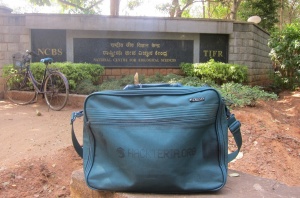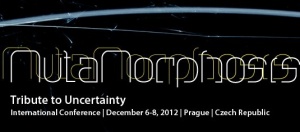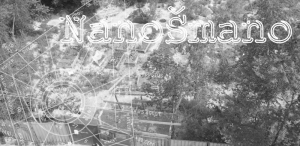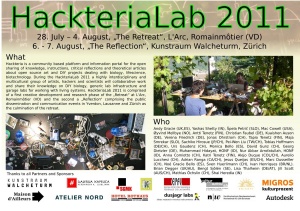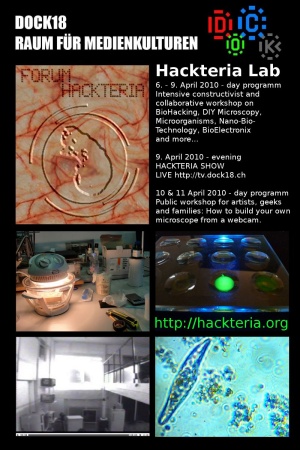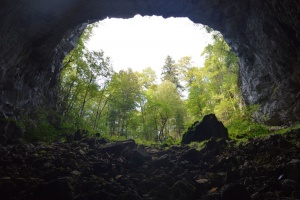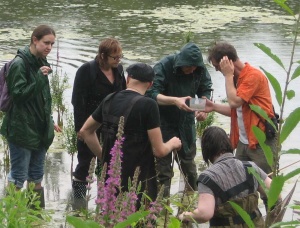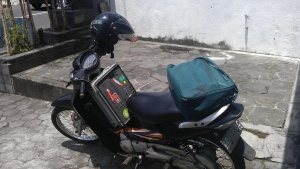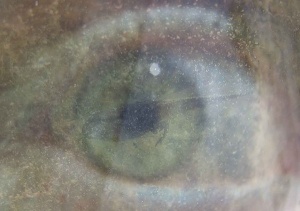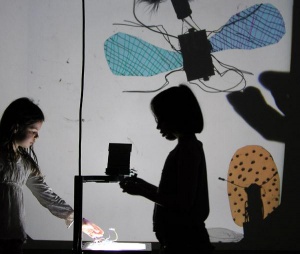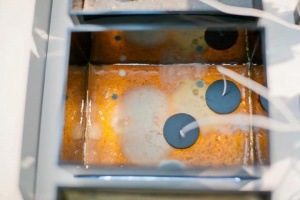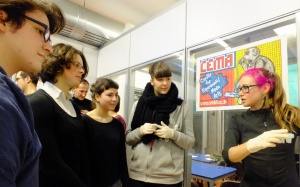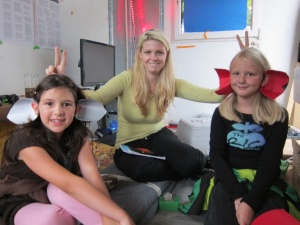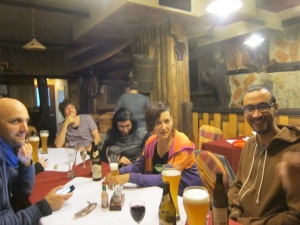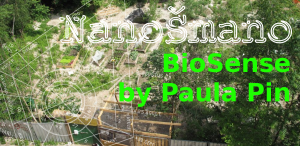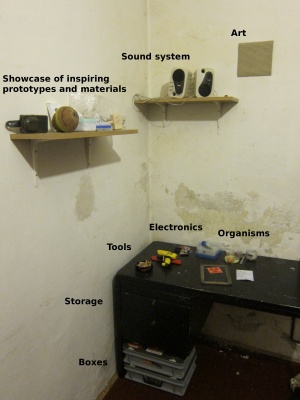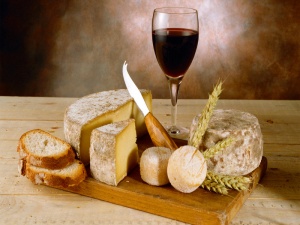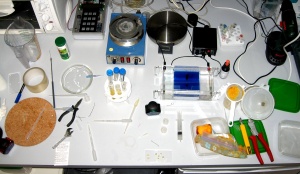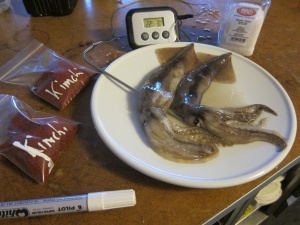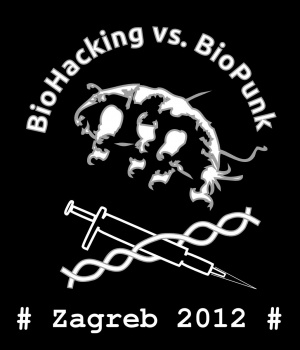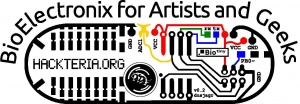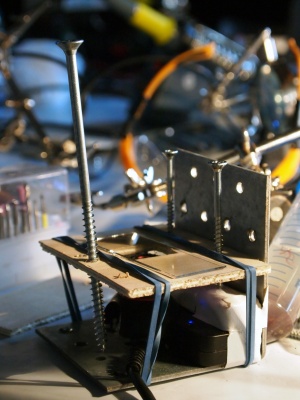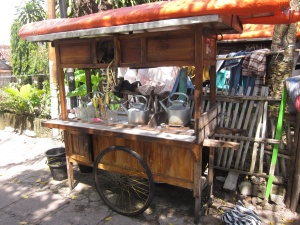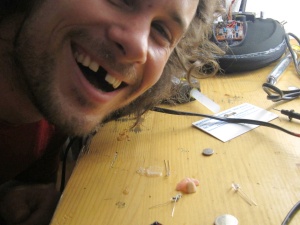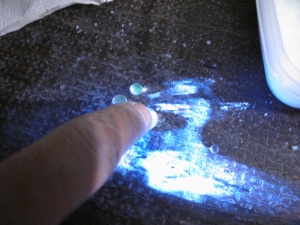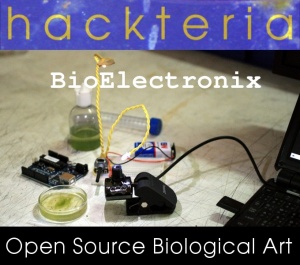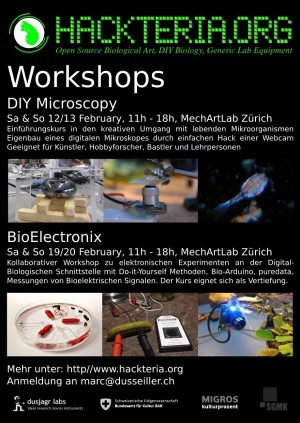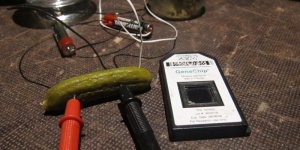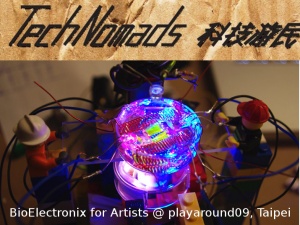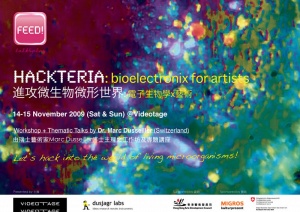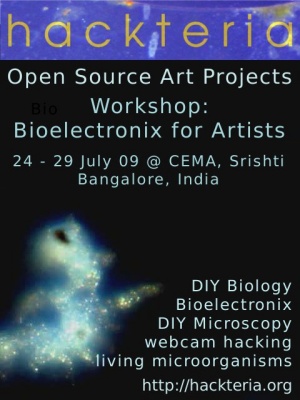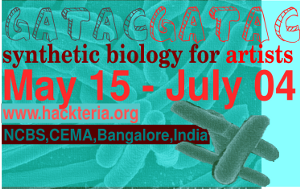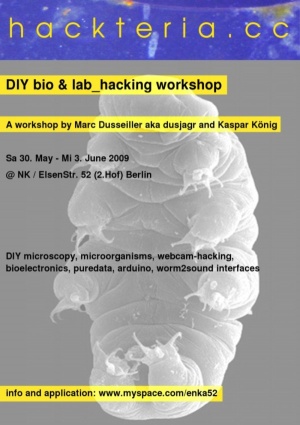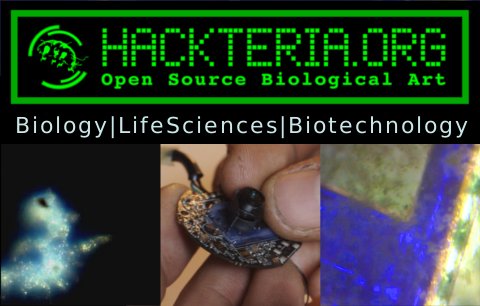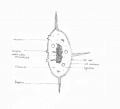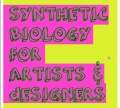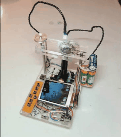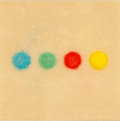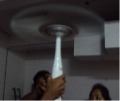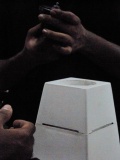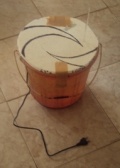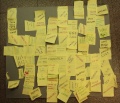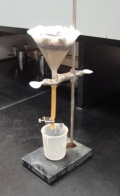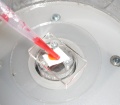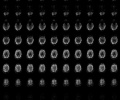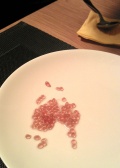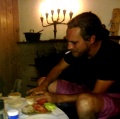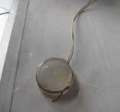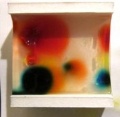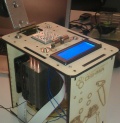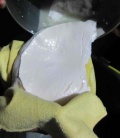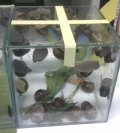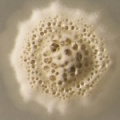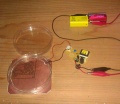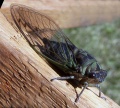Old Main Page
| Maillists |
|---|
| Hackteria Kitchen
Subscribe here General discussions, questions, news and info surrounding all topics about Open Source Biological Art, DIYbio, hackteria related events, tardigrade hunting, Art/Science, lasers, DIY microscopy, synthetic biology for artists, KitchenLabs, fungi, BioHacking, DIY fermentation, BioElectronix, workshops and labs... Main maillist for all former participants of workshops and labs, who want to stay in contact with the network. See the archives (Aug - Sep 2011) of the old Lab2011 list here |
| Workshopology
Subscribe here The Workshopology list is about people sharing the same enthusiasm and opinions, dreams and thoughts about developing new and alternative educational methods, having fun learning/teaching, transdisciplinary approaches, enjoying collaboration with people (be it children, hackers, artists, teachers and whoever wants to learn anything) and generally like sharing their knowledge and experiences. The topics are not limited... See the archives (Oct 2011 - Jan 2012) of the old list from the Symposium at KIBLIX here |
| General News and Info Newsletter
Subscribe here Only outgoing mails by editors, 4 times per year. |
| admin Maillist |
| Labs |
|---|
| HackteriaLab 2014 - Yogyakarta
HackteriaLab 2014 - Yogyakarta April 2014 Error creating thumbnail: File missing
|
| HackteriaLab 2013 - Bangalore
28. Jan -12. Feb 2013
|
| MutaMorphosis:Nomadic Science Lab
MutaMorphosis:Nomadic Science Lab 3. - 7. Dec 2012 |
| NanoŠmano - LifeSystems
September 2012 |
| HackteriaLab 2011 - Romainmotier
HackteriaLab 2011 - Romainmotier August 2011 |
| Hackteria Lab - Dock18 - April 2010
Hackteria Lab - Dock18 - 6-9 April 2010 April 2010 |
| BioTehna |
|---|
| Field Trip: |
| Field Trip: |
| Hackathon:
Mobile Labs Hackathon, Ljubljana
|
| Workshop:
BioKino and BioVJ, GT22, Maribor
|
| Workshop:
SoftBots & OverheadBots with "derstrudel" and Ralf Schreiber, Ljubljana |
| Kapelica Swiss Tour:
3 - 8. May 2013, Jurij Krpan (SI)
|
| Workshop: |
| Workshop: |
| Workshop: |
| Symposium:
24. Nov 2012, 18h - 22h, Ljudmila
|
| Workshop: |
| Workshop: |
| BioTehna Lab Infrastructure: |
| Workshops |
|---|
| Workshop / Temporary Lab:
NanoHacking: Converging Life and Tech at the Nanoscale - BiofiliA HighSchool, Finland 2-5. Dec 2013 |
| Workshop / Temporary Lab:
Hackteria FoodHacking - BioLab @ CynetArt - Dresden, Germany |
| Workshop / Temporary Lab: |
| Workshop:
The Art of BioHacking or How to make Cheese and Wine, HEAD, Geneva |
| Workshop: |
| Workshop: |
| Workshop: |
| Workshop: |
| Workshop: |
| Workshop: |
| Workshop: |
| Workshop: |
| Workshop: |
| Workshop: |
| Workshop: |
| Workshop: |
| Workshop: |
| Workshop:
Bioelectronics for artists @ CEMA
20. July - 28. July 2009
|
| Workshop:
Synthetic Biology for Artists and Designers@CEMA,NCBS 15. May-01. July |
| Workshop:
hackteria & lab_hacking @ NK, Berlin
30. May - 3. June 2009
|
| People: Artists and Designers working with Biology, Bio-technology and Bio-Ethics |
|---|
| Symbiotica |
| Critical Arts Ensemble |
| Dunne and Raby |
| Joe Davis |
| Eduardo Kac |
| Phil Ross |
| Stelarc |
| Beatriz D' Costa |
| Rich Pell |
| Center for Post Natural History |
| Natalie Jermejenko |
| Andy Gracie |
| Marc Dusseiller aka dusjagr |
| Jay Barros //BioMusic - Sounds of Science // |
| Guy Ben-Aury |
| Gabriel Harp |
| Anab Jain |
| Verena Friedrich |
| Anthony Hall |
| Adam Zaretsky |
| Brandon Ballangee |
| C-Labs |
| Boo Chapple |
| Marta de Menezes |
| Victoria Vesna |
| The Office of Experiments |
| The Department of Fun and Games |
| Allison Kudla |
| Suzanne Lee |
| Kathy High |
| Jennifer Willet |
| Maróy Ákos |
| Julia Reodica |
| Arvind Gupta |
| (((1/f))) Rohit |
| Frederik de Wilde |
| Andrew Pelling's BioArt website |
| Guto Nóbrega |
| Papers,Conferences and Journals |
|---|
| Leonardo |
| Synthetic Biology 3 Zurich[4] |
| Biointerphases[5] |
| Lab on a Chip[6] |
Welcome to Hackteria.org
Hackteria is a collection of DIY Biology, Open Source Art Projects that use Biology, LifeSciences, Biotechnology.
editing the hackteria wiki Sandbox
| Projects |
|---|
| Project 1: The Bacterial Net- Microbial Telecommunications.
Quorum sensing is a type of decision-making process used by decentralized groups to coordinate behavior. Many species of bacteria use quorum sensing to coordinate their gene expression according to the local density of their population.The Bacterial Net attempts to transfer this decision making process over the Internet. Using Microcontollers and sensors to detect bacterial population and a public web service http://www.pachube.com that helps transfer sensor information. The Bacterial Net is an exploration in bringing the Internet into the Natural Ecosystem. |
| Project 2: Bioelectronix
Integrating electronics into biological culture devices needs different approaches. the use of silicone-rubbers for sealing off the wet/humid bio-part from the silicon circuits and sensors allows the making of hybrid bioelectronic devices. |
| Project 3: Synthetic Biology for Artists and Designers: A primer
An Illustrated handbook that shows you how to work with MIT's parts registry |
| Project 4: ArtScienceBangalore 2009-Synthetic Biology for Artists and Designers
see also the docu for Prix Ars Electronica
|
| Project 5: DIY microscopy
a small hack to the optics of a standard webcam with an adjustable focus-lens, allows to create video data, with a magnification of around 100 to 400x (depending on the model) at a working distance of a few mm. The highest magnifications can be achieved by inverting (putting upside down) the lens. Addition of good lighting by the use of leds allows to create images using a bright-field method (shine through the stuff) or dark field method (look at the reflections and scattering). |
| Project 6:DIY $25 Gel Box
Building your own Electrophoresis Gel Box is easy. Here's how you do it! |
| Project 7: bio habitats
instead of using standard lab culture tools, such as flasks or petri-dishes, artists might want to design their own devices to culture and inhabitate living organisms and keep them alive. simple devices can be cast in silicone to incorporate all the necessary environemtal conditions for long time survival of microorganisms. |
| Project 8: DIY Microfluidics |
| Project 9: DIY Plant Tissue culture and Engineering |
| Project 10: Pd_microscope
Pd_microscope is the software package that you can use to control your DIY microscope. It's a work in progress |
| Project 11: DIY spectroscopy
Spectroscopy means the analysis of natural phenomena according to its energy distribution. In case of the electromagnetic spectra, ranging from x-ray, visible light, infrated to radio frequencies, this can be used to analyse chemical compounds, follow biochemical reactions or get information of the composition of stars. This project tries utilize webcams, CD/DVD and some construction material, to get a spectral analysis of ultra-violett and visible light sources, which might be used to follow enzymatic and metabolic reactions in cultured microorganisms and bacteria. |
| Project 12: ArtScienceBangalore 2010-Synthetic Biology for Artists and Designers
A bunch of regular people with very little idea of Synthetic Biology but ready to pick up eveything about it. Download the nicely illustrated Comic Book on Synthetic Ecologies here File:IGEM Comic 2010.pdf |
| Project 13: DIY handheld centrifuge |
| Project 14: DIY table top centrifuge |
| Project 15: DIY Incubator
|
| Project 16: DIY Fermentation or the Art of making Wine |
| Project 17: Hacked Optical Mouse |
| Project 18: DIY Sterlisation Hood |
| Project 19: DIY Water Bath |
| Project 20: GFP Protocol Jugaad
Home made GFP bacteria |
| Project 21: ReacTable
Gives information and protocals of equipment and bacteria put on it |
| Project 22: Algae Culture at Home
Grow your own algae at home with some plastic bottles, lighting and air bubbles |
| Project 23: Mobile Phone Field Microscope
Modify a mobile phone into a useful field microscope by replacing the lens with a cheap flipped wemcam lens.. |
| Project 24: DIY turbidity meters
simple light absorption measurements for water monitoring or nanoparticle detection using an arduino, a laser or LED and an LDR. |
| Project 25: Laser-cut microscopy stages
Error creating thumbnail: File missing different design for easy to build stages for the DIY microscope, z-stage, x-y servo controlled stage and more... |
| Project 26: How to start a nanolab
Because nanotechnology is situated at the interface of many disciplines it is best to organize some basic gear from various sources, such as a local electronics store, gardening shops or various online suppliers for household tools and electronic gadgets. You will need to set up some basic laboratory instruments for doing simple biology, chemistry, fabrication&manufacturing and some physical computing to connect everything to your computer. |
| Project 27: Magnetic stirrer
always useful to stir things automatically if you are lazy... |
| Project 28: DIY Micro Dispensing and Bio Printing
dispensing, cutting, printing, growing with a robotic platform. Aka NanoFabrik |
| Project 29: ArtScienceBangalore 2011-Synthetic Biology for Artists and Designers
Download the nicely illustrated booklet on "Dirt" here File:Dirt IGEM2011.pdf |
| Project 30: ArtScienceBangalore 2011-Nanotechnology for Artists and Designers |
| Project 31: TEMPE(h) : THE INSTRUCTIONS
Error creating thumbnail: File with dimensions greater than 12.5 MP Tempe(h) is a fermented food. But it's not meant to preserve the material from rottenness. It's for style. Analogue meat they said. So, once you made your own tempe(h). Cook it! Eat it!
|
| Project 32: Daphniaology
|
| Project 33: Ants
|
| Project 34: Book: Homemade Biological Art |
| Project 35: The Art of Hunting
Baerman funnels, Berlese-Tullgren funnel, habitats |
| Project 36: Jugaad PCR Thermocyclers
some links to alternative and DIY thermocycling experiments. |
| Project 37: MobileLabs
some links and ideas to mobile labs... |
| Project 38: Autonomous Public Lab
Blueprints for setting up a People's Research Lab |
| Project 39: Hackteria Merchandise and Logos
loads of logos, t-shirt designs, stickers, flyers and posters |
| Project 40: Orbital Shaker
shake it baby! |
| Project 41: Plant Electrophysiology
Yeah, even plants cant be protected from arduinos.. |
| Project 42: Spin Coater
DIY Spin Coater! |
| Project 43: NeuroNetworking
Prototypes & design fiction into networking over brain data and biodata related to our brain function (fMRI, SNPs, EEG). How will we use brain data for social networking, neuromarketing, citizen science projects,etc. The main technical challenge is to create some open format for sharing brain data over the web (3D T1-weighted gradient-echo sequence (MP-RAGE)images in the nifti format http://nifti.nimh.nih.gov/nifti-1 , which is readable by FSL software (http://www.fmrib.ox.ac.uk/fsl/ into some 3D web browser data and image that would support crowdsourcing of brain data, pattern recognition and comparison of brain data). |
| Project 44: Garden 2012: Spherification of Hieronymus Bosch
Spherification experiments as a tribute to Hieronymus Bosch's Garden of Earthly Delights. In order to understand our new cosmology of minimal but also complex spheres (molecules, cells, vesicles, coacervates, microspheres), we decided to use spherification techniques and to try to design a version of Bosch's Garden of Earthly Delights like a catalogue of what is possible in terms of spheres today. Some of our spheres are eatable, other are perceived only by microscopes, some target taste buds other just molecules, we even tried to prepare a micro-meal for microorganisms entrapped in a type of mini-aquaria and systems. The three containers mimicking the original triptych are an early reflection of the importance of spheres for our idea of origin or the organic life but also present experiments in molecular gastronomy but also drug targeting systems and research in nano-bio technologies. Humans making spheres on all scales are like gods recreating some new garden with self-enclosed systems, ecologies and microspheres, which influence each other and interact. |
| Project 45: Bio+Hacker+Art-Space Tour California 2012
Picture protocoll of an intensive three week travel throug the venues of third culture in western California!
|
| Project 46: Distillation
Distillation at the Hackteria Distillery at Jagaa, Bangalore Dec. 2012 and other distillation rigs |
| Project 47: Do eat your laser Tofu (DEYLT)
How to make your own tofu? From laser cutting a tofu mold to the preparation and the tasting. |
| Project 48: Randen-Burger or the art of documenting
... |
| Project 49: Yeast powered balloons a la BioCyberKidzz
This is a balloon, which inflates as a result of the yeast growing and interacting with its environment |
| Project 50: Bacterial Jewelry a la BioCyberKidzz
The Bacterial Jewelry module comes as a take away amulet that has a living fingerprint of the participant.
|
| Project 51: Body Augmentation and Enhancement a la BioCyberKidzz
Talking about bioart and cyberbody modifications is accessible to everyone. |
| Project 52: The LAB BOOK a la BioCyberKidzz
Recording observations is an important aspect of laboratory life. This module is to encourage the collection and recording of data. |
| Project 53: DIY Laser tweezer, cell trap, oligo synthesis
Based on a paper of a laser tweezer made from an old DVD drive we go on...
|
| Project 54: DIY Plasma generators
Where to get it, how to make it, the 4th state of matter. |
| Project 55: Hacked Hard-disc Centrifuge
Get an old harddisc, laser cut or 3D pring a eppi-holder, run it... |
| Project 56: Agar is the Media
The key technologies of every genetic and molecular biology lab – the gel electrophoresis chamber...
|
| Project 57: BubbleBots
Tiny little tubular rockets generating bubbles to propel themselves through water. |
| Project 58: Ganzfeld experiment
This is a modified experiment from the 70s and which can be used as a great icebreaker activity for building trust. |
| Project 59: Rubber_Hand_Illusion_Experiment_variations
a variation developed through trying this workshop on a large number of people, and not having funding to get loads of rubber hands. So we made the hands in the workshop. |
| Project 60: Internet of Bugs'n'Beasts
starting soon |
| Project 61: KIMCHI or the Art of Fermentation
HomeMade KIMCHI from scratch..... The final taste all depends on the amount of salt, dehydration, fermentation and temperature monitor.
|
| Project 62: Science For Poets
LifeSciences Workshop for Artists & Designers in Bangalore 2013, collaborators of biodesign.cc |
| Project 63: Zebrafish Hacking: The Plant Animal
|
| Project 64: Wild OpenPCR
Building an OpenPCR without the kit, just from commercially available parts. With additional information on how to do it.
|
| Project 65: Explorations in BioLuminescence
From fireflies to stinky squids... the future is bright
|
| Project 66: Say Cheese
make your own fresh cheese
|
| Project 67: Hack a Taq
Testing out the Wild OpenPCR and purifying your own Taq from Open Biotechnology - using primers to detect coliform bacteria |
| Project 68: Poor Man's BioPrinter
There are many ways of bioprinting... |
| Project 69: DIYbio Prototypes Collection & Hackteria archive
Collection of open biology and DIYbio prototypes created by members of the Hackteria network, such as DNA Lab-in-Box, Gene gun etc. This archive of exhibition artefacts supports open science and citizen science advocacy and showcases the open hardware possibilities of supporting research in the Global South. |
| Project 70: Urban Cuisine
Various explorations into urban ecologies and recipes to hunt, collect, grow, cook, eat your findings |
| Project 71: Actinomycetes Tournament: Open antibiotics discovery
In this project we want to screen soil bacteria, such as Actinomyces, Streptomyces and Micromonospora for antibiotic properties. It is a global citizen science initiative started by DIYbio Waag, which uses game elements (collecting and tournaments) to support open drug discovery of antibiotics. We will isolate actinomycetes from soil samples around the world and screen with Micrococcus luteus or similar microbe to determine their antibiotic properties. Images of inoculated plates will be shared online and based on their strengths (zones of growth inhibition) they will become part of a collection or initiate tournaments between the most successful examples. We will sequence the most powerful ones. We expect cooperation with various DIYbio organizations, microbiology departments and science enthusiasts. Picture: Antibiotic Producing Actinomycetes By adonofrio (Biology101.org) |
| Project 72: High Voltage Epigenetics
Is it real or is it epigenetics? A novel method is described, which, on the basis of the short-term application of electrostatic fields, results in lasting beneficial and desirable properties in animals and plants. The culture of fish, particularly of edible fish but also of ornamental fish, is genuinely revolutionised. |
| Project 73: How to make a proper Barber Trap |
| Project 74: doms Mobile vj lab
As time past I have grow huge need for mobile vj lab for all indoor and outdoor visual activity. From my experience till now it has to be paced with lots of power, projector, cams, microscope,sound system, bio lab tools (pipettes, slide glass...),many different vj tools(blinking led...), lasers, traps and containers for live organisms. Probably some other stuff that I will find useful like knife, glue, bugs 2d aquarium, different plugs for charging and powering that you always find helpful on terrain. Of course all together should not be to heavy (5kg max but rather 3kg).... ... |
| Project 75: openTrap
More and more we are looking into various traps for catching larger animals such as rats, foxes, pigeons and more. Re-developing some popular designs, adapting them, make them open source for digital fabrication ...
|
| Project 76: DIY_NanoDrop
Microvolume Spectrophotometers and Fluorospectrometers are innovative products used to quantitate micro-volumes of sample. You want one? Build your own. ...
|
| Project 77: Nail Studio Micro Fluidics
Nail studios are the girls secret hight tech labs with UV light curing gel and other fancy stuff. Let's hack it to do low cost microfluidics. ... |
| Project 78: Mobile Power Solutions
You need mobile electrical power - On how to build Graphene Supercapacitors, Peltier electricity from fire and more... |
| Project 79: Fish-Hacking
Ever tried to listen into the electrocommunication behavior of weakly electric fish? Recent experiments and general info about black ghost knifefish, inspired by Tony Hall's work on ENKI technology. They have also been shown to be useful for biomonitoring of pullutants in water! Fish-2-pd interfaces are already working nicely. |
| Project 80: Long Range Microphone for Cicadas & Cricket Hunting
Imagine you are in the forest, rivers, or mountains and some noises just appears and hunting your ears and you kind of wanted to be sure what is it and where is it come from. This long range microphone might help you to solve the mistery. But, as the title says it will be used for hunting cricket and cicadas a.k.a garengpung, then we must have some ideas about how the cricket and cicadas a.k.a garengpung sounds like. - still under construction. |
